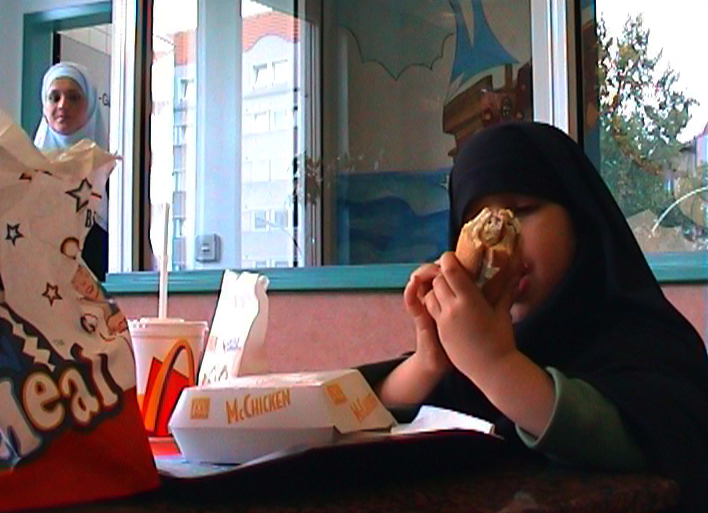
video still
HAPPY MEAL, 2004
PAL video, 12:10 min., Stereo, non-Dialogue
Performer Lara Entekhabi
Parable of the Garden
...
Karan KapoorShahram Entekhabi’s purpose in creating Happy Meal transcends a mere acknowledgement of the globalization phenomenon. He is particularly interested in the question of identity. In fact, much of his work seeks to explore how Muslims living in the West strike a balance between Islamic tradition and Western influence in this rapidly globalizing world, in which they have equal exposure to both. With this in mind, Entekhabi hones his analysis of migrant identities to consider the notion of visibility versus invisibility, and whether the culture that these immigrants bring with them from home is truly “seen” by others in their newly assimilated environments. Happy Meal seems to be an anomaly within the context of Shahram Entekhabi’s usual work. Here, not only does he deviate from his usual schema of using characters who are either migrant workers or fundamentalists, but his message also seems to be far more optimistic and playful. This video depicts the intersection of two seeming antipodes of today’s society: Islam and Western corporate capitalism. Happy Meal chronicles a little Muslim girl as she excitedly eats a McChicken.
Happy Meal in a German McDonald’s. At times, it seems very apparent that the chador which she is wearing gets in her way as she tries to finish her sandwich and then remove the Happy Meal toy from its plastic covering. This continual interference is a metaphor of the often contentious relationship between Islam and the Western world. The background music throughout the piece is a cycle of two catchy children’s songs praising Allah that also serves to highlight the juxtaposition of Islam against the West. Watching the progression of the work unfold, one witnesses a moment in which these two antipodes converge, and all differences are evinced. It is a moment when all the external factors – the politics, the prejudices, the stereotypes – that accompany life as a Muslim living abroad cease to be. After much grimacing and machination, the girl is finally able to overcome the “burden” of her chador and remove the plastic covering of her Happy Meal toy. At this moment the girl seems truly and completely happy. Aimee Marcereau DeGalan describes this point in time as when “the possibility and excitement of new cultures being created.” Indeed, the creation of a hybrid “third culture” is the main message that Entekhabi is seeking to convey through Happy Meal. The third culture is one that embraces ideas from both the East and the West, and that threads them together instead of forcing them apart.
Excerpt from exhibition catalog: Parable of the Garden, new media art from Iran & Central Asia 
Curated by: Leeza Ahmady ( ), Sarah Cunningham (
), Sarah Cunningham ( ) and Deborah Hutton
) and Deborah Hutton
The College Art Gallery, The College of New Jersey, USA 
The video "Happy Meal" is part of the permanent collection in the video forum of the Video Forum of the Neuer Berliner Kunstverein (n.b.k.) 
"Happy Meal" appeared at the following exhibitions and festivals, among others:
2015: "tranzit .ro" Gallery of Contemporary Art, Bucharest Romania2012: Shahram Entekhabi: Happy Meal — curator Dr. Aimee Marcereau DeGalan, Fleming Museum of Art, University of Vermont, USA
2011: In the mood for today — Public screening, 29th and 30th Street, Manhattan, New York, USA
2011: Jardim como espelho (The Garden as a mirror) — curator Rui Mourão, Goethe Institute, Lisbon, Portugal
2011: In the mood for today — Curator Macu Morán, Fundación Alianza Hispánica, Madrid, Spain
2010: I love my God — steirischer herbst festival, Festivalzentrum im Orpheum, Graz, Austria
2010: In-Between: Negotiating Diasporic Identities, curator Charlotte Bank, Casino forum d'art contemporain, Luxembourg
2009: My Favourite pastime — Artprojx Space | Artists Film Club
2009: 10th Havana Biennial – curator Blanca de la Torre, Havana, Cuba
2009: Middle East Video Channel — curator Khaled D. Ramadan, Ullens Center for Contemporary Art (UCCA), Beijing, China
2009: The Promise of Loss. — curator Shaheen Merali, Hilger Brot Kunsthalle, Vienna, Austria
2009: Das Böse ist ein Eichhörnchen — Museum in der „Runden Ecke“ (Stasimuseum), LOFFT Leipzig and Werkstattmacher e.V., Germany (catalogue)
2008: Parable of the Garden: New Media Art from Iran & Central Asia — curator Sarah Cunningham, College of New Jersey, Ewing, NJ, USA (catalogue)
2007: Comm'è amaro stu ppane — curated by Jacques Cerami, Palais des Beaux-Arts, Charleroi, Belgium (catalogue) 2007: EVR Boston, E-Flux Video Rental, Carpenter Center for the Visual Arts, — Boston, USA
2007: War of the Buttons. Children and the World of War — Århus Kunstbygning Center for Contemporary Art, Århus, Denmark
2007: Sin cobertura. Independent Video from the Middle East— Museo Nacional Centro de Arte Reina Sofía, Madrid, Spain
2007: Comm'è amaro stu ppane – curated by Jacques Cerami, Centre d’art Nei Liicht, Dudelange, Luxembourg (catalogue)
2006: Busan Biennale — Busan Museum of Modern Art, Busan Yachting Center, Korea (catalogue)
2006: Middle Eastern Project , interdigitate New Media Festival, MIC (The Moving Image Centre) — Newton, Auckland, New Zealand 2006: Almost Art — curator Osvaldo Romberg, — Slought Foundation, Philadelphia, USA
2006: Diagnosticians, SPARK Video Canada Festival — Forest City Gallery, London, UK
2006: dLux Media Arts international, the Middle Eastern Video Project — Sydney Opera House, Sydney, Australia
2006: Festival International de Film et Video de Creation Cinéma Empire Sofil, curator Nat Muller — Achrafieh, Beirut, Lebanon
2006: 100 TAG = 100 VIDEOS — Heidelberger Kunstverein, Heidelberg, Germany
2005: In the Shadow of “Heroes” — ArtEast Social organization, Bishkek, Kyrgyzstan (catalogue)
2004: Schizorama — National Center for Contemporary Art/NCCA, Moscow, Russia
2004: I?”, PLAY_gallery for still and motion picture, Berlin (solo show), 2004